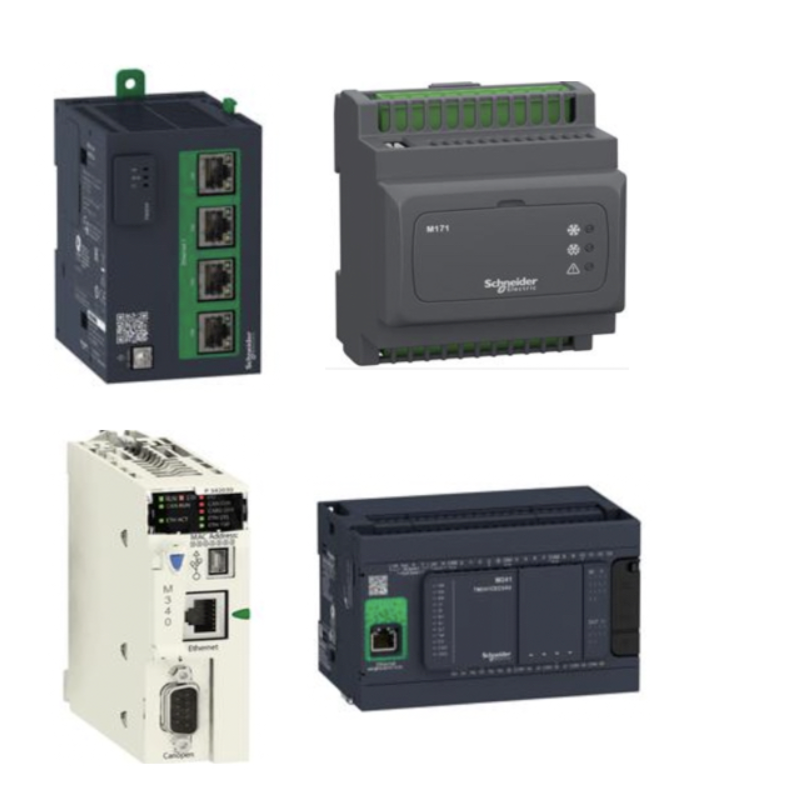Modicon PLCs & Accessories

Programmable Login Controllers (PLCs) and Programmable Automation Controllers (PACs) are industrial computers that are built and designed for manufacturing environments. They are the brains of the operations, providing highly reliable control of automation equipment. All automation systems are built with a PLC or PAC to control individual machines or stations. Determining which one to use comes down to the process’s complexities and scalability.
Programmable Logic Controllers (PLCs) are computer control systems that detect the state of all input devices connected to it, make a decision based on a user-created program and then, output commands to any devices connected to it. PLCs monitor, control and communicate automated processes and act as the physical interface between devices and a SCADA or HMI system. PLCs are best suited for simpler processes and smaller automation projects that do not require rapid scalability. They are ideal for both simple and high-speed machine control and can be found in assembly equipment, motion control and dispensing systems.
More Information about Modicon PLCs & Accessories
Programmable Automation Controllers (PACs) can be used to communicate, monitor and control equipment across multiple devices and networks. They utilize network technologies and standard protocols such as Ethernet, Structured Query Language (SQL) and OLE for Process Control (OPC). PACs provide more flexibility in programming, larger memory and better scalability for future expansion. They are useful in systems that have a high percentage of analog IO and can be implemented in systems with extensive network interface requirements. PACs often handle higher levels of coordinated motion such as dual axes and multi-axis motion. They are also well-suited for vision applications, including vision-guided motion.
FAQs
Can a power supply module be used with a Modicon PLC?
Yes, a power supply module can be used with a Modicon PLC. The power supply module provides regulated power to the PLC's CPU, I/O modules, and other connected devices.
Does a programming cable come with a Modicon PLC?
Some Modicon PLCs come with a programming cable included in the package, while others do not. For example, some Modicon M340 and M580 PLCs come with a programming cable included, while other models such as the Modicon M221 do not.
Is a Schneider programmable logic controller the same as a Modicon programmable logic controller?
Yes, a Schneider programmable logic controller (PLC) and a Modicon programmable logic controller (PLC) are the same in that Modicon is Schneider Electric’s PLC brand, offering a range of automation controllers for industrial applications.
PLCs
Programming Logic Controllers (PLCs) are industrial computer that are designed to monitor and control a series of inputs and outputs.
The program running the PLC evaluates the inputs, and changes the output signals based on the program response to the input signals. Several programming languages are available to program most PLCs. The most common of these is called ladder logic. Ladder logic is a visual programming language that evolved from relay logic diagrams, which visually look like ladders because they consist of two vertical rails with runs between them that contain programmed logic. While ladder logic is the most common programming language used within PLCs, there are others that are also common, including function block diagrams, structured text and sequential function charts.
The hardware included in a PLC includes: a CPU, memory, I/O connections, a power supply and a programming device.
The CPU is a microprocessor that acts as the brains of the PLC. It performs logic operations, controls instruction and performs various other tasks that help keep the PLC running effectively. The memory in a PLC allows data to be stored that is needed to run the program, as well as any data that is collected by the inputs. Depending on the the type of PLC, the section for I/O may have a fixed number of points or it may be modular, allowing for additional I/O to be added. Many PLCs require some type of power supply and it is common to see more modular based systems integrate the power supply. Lastly, the PLC provides a programming device that feeds the program into the PLC's memory, so that it can perform the desired operation. This is most commonly some type of computer.
The PLC is designed to run a program repeatedly over and over again, normally many times a second. Each time a program runs, the PLC goes through some very specific steps.
While the order and the specifics may vary from manufacturer to manufacturer, they all typically follow a pattern similar to the following:
The PLC performs internal self checks to make sure that it is functioning correctly.
The PLC reads the inputs that are connected to it. It will then store the status of each of those inputs in its memory.
The PLC will execute the program logic.
The PLC will write the new values to the hard wired outputs to match those determined during the program execution. At some point in the cycle, communication requests will also be processed.
Following the execution of the last step, the PLC will then cycle back to the beginning of the process and begin all over again.

